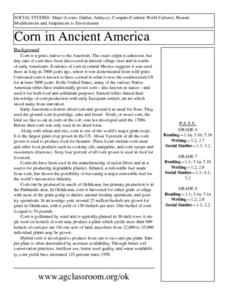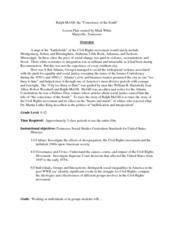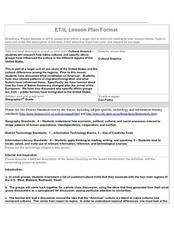Curated OER
Traveling Through North America
Students identify places and landmarks in North America, specifically Canada and the United States, by using and constructing maps. Six lessons on one page; includes test.
Curated OER
South American Countries: Area Activity
In this area learning exercise, students use a table with a an area given for Argentina in square kilometers, then use that to complete the table, finding area for other South American countries.
Curated OER
The Roanoke Mystery
Fourth graders hypothesize about what happened on the island of Roanoke. In this South Carolina history instructional activity, 4th graders use primary documents to draw conclusions about what happened to the Lost Colony of Roanoke. This...
Curated OER
The Discovery of the Americas: A Play About Early Explorers
Students perform a play about the early explorers to America.
Curated OER
Corn in Ancient America
Middle schoolers explore the importance of corn to the survival of early civilizations of the Americas. Through research and discussion activities, they read and describe how corn was used as food and currency in early civilizations. ...
Curated OER
The African Slave Trade: From West Africa to South Carolina and Beyond
Eighth graders explore the African slave trade. They identify the principal figures practicing the African slave trades at three locations. Students draw the physical routes of the slave trade on a map and they list the reasons for the...
Curated OER
Antisemitism in Early America
Eleventh graders explore the rise of antisemitism in the United States in the early 20th century. After reading a passage concerning one man's ordeal, 11th graders discuss how the civil rights of minority groups has been viewed in...
Curated OER
The South Wins Gettysburg!
Students explore American Civil War, hypothesize that the Union Army was defeated at Gettysburg by Lee's army, and write an essay describing how different North America would be today if the South had won the Civil War.
Curated OER
Why Do Geese Fly South For the Winter?
Fifth graders examine migration by tracing animal migration routes on a map. In this animal life lesson, 5th graders observe a map of North America and read about the migration patterns of geese. Students trace the path most geese take...
Curated OER
How did rice first come to America?
Students discover how rice first came to America. In this rice history lesson, students discuss how a boat captain gave people a bag of rice seeds for fixing his ship. They draw a picture of a ship and create pictures that show how the...
Curated OER
Ralph McGill: the "Conscience of the South"
Young scholars view a film, "Dawn's Early Light: Ralph McGill and the Segregated South." As groups of students observe the movie, they list key dates, significant persons interviewed, and cultural characteristics. Upon completion of the...
Curated OER
Cultural America
Seventh graders investigate the cultural differences that can be found in America. They discuss what it means to be called an American. The patterns of migration to America are discussed with the use of maps and geographical terms....
Curated OER
Interest Groups in South Carolina
Twelfth graders explain the work of interest groups and give examples of South Carolina interest groups. They identify positive & negative influences of interest groups in U.S. & S.C. politics. They take and defend a position on...
New York City Department of Education
Geography and Early Peoples of the Western Hemisphere
Young historians discover the early people of the western hemisphere. The unit explores how the land changed, how it was used and homes of early Americans such as Incas, Mayans, Inuits, Aztecs, and Pueblos. Individuals also examine these...
Curated OER
The Seven Continents Scavenger Hunt
Who doesn't enjoy an engaging scavenger hunt? Here, scholars listen to, and discuss, the informative text, Where is my Continent? by Robin Nelson. They then explore the seven continents and four major oceans using Google Earth.
Smithsonian Institution
Spirits Across the Ocean: Yoruban and Dahomean Cultures in the Caribbean Brought by the Slave Trade
Much of Latin American music owes its origins to the slave trade. Peoples from the Yoruban and Dahomean cultures brought with them the distinctive rhythms, time signatures, and eighth note patterns that now characterize Caribbean music....
Council for Economic Education
The Columbian Exchange
What did you have for dinner last night? Many scholars ask that question without considering the history behind the foods they eat. Using a simulation, scholars investigate how the foods they eat are the product of the Columbian...
Teaching Tolerance
Why Do We (Still) Celebrate Columbus Day?
What are we really celebrating on Columbus Day? The resource explores the narrative behind Columbus Day and ways for people to change the perception. Scholars also review vocabulary terms associated with the topic and how attitudes have...
University of California
Was Slavery Always Racial?
The lesson focuses on slavery in the ancient world and asks academics to decide if it was always about race. Scholars view primary sources, participate in a short discussion, and complete a worksheet to understand how slavery in the...
University of California
The Virgin of Guadalupe
A worldly resource focuses on the transfer of goods, ideas, and religion that took place as part of the Columbian exchange. Academics view sources such as text and artwork to help them complete a worksheet.
National Endowment for the Humanities
Slavery and the American Founding: The "Inconsistency Not to Be Excused"
High schoolers examine slavery in the revolutionary and colonial eras of the United States. In this slavery lesson, students investigate the presence of slavery in early America, the language of the Constitution, and the intent of the...
Curated OER
American Culture in a Musical Setting
Students discover the significance of similarities and contrasts of three separate cultures of the United States through music. They take out maps and trace the expedition of the Spanish along the coasts of Mexico and North and South...
Curated OER
Cities and Seasons
Students explore how satellite images show seasonal changes in seven cities in North and South America. Through a sequence of images, they study the green-up and brown-down of the seasons and how seasons change over time. Afterwards,...
Curated OER
Latin America and the Caribbean in the Classroom: The Economy and Trade
Learners use the internet to gather information on daily exchange rates. They calculate the exchange rates between two countries by role playing they are going on vacation to these destinations.
Other popular searches
- South American History
- Biomes of South America
- Geography of South America
- American South
- South America Worksheets
- Geography South America
- South America Culture
- South American Art
- South American Culture
- South American Music
- Countries in South America
- South America Countries

























